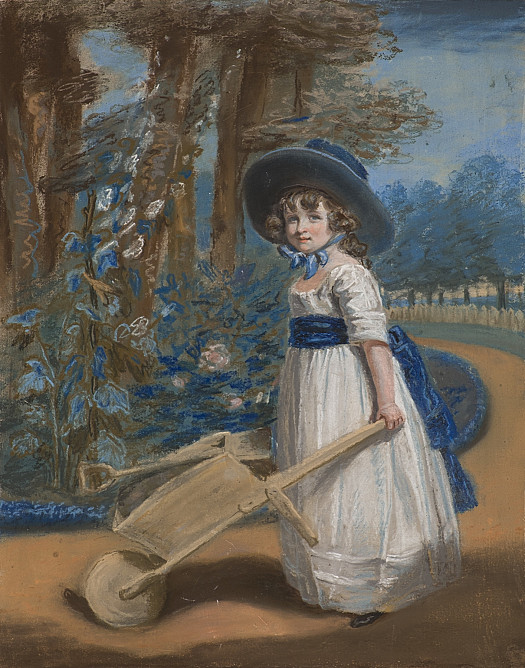John Russell was one of England’s leading portrait painters, who enjoyed critical acclaim and financial success comparable his friend and contemporary, Sir Joshua Reynolds. He produced technically and aesthetically brilliant works in pastel, using a sfumato effect achieved by blurring with the finger and crayon.
John Russell was born on 29 March 1745 in Guildford, the second child of John Russell and Ann Parvish. His father was an artist, book and print-seller and served five times as mayor of Guildford. John Russell was educated at the Royal Grammar School in Guildford, before winning premiums at the Society of Arts in 1759 and 1760. He was then apprenticed to the artist Francis Cotes (1726-1770), who would become one of the founding members of the Royal Academy in 1768.
Cotes became a close friend and mentor to Russell, and as one of England’s pioneering pastel painters, introduced the technique to him, influenced by the work of the Italian pastel artist Rosalba Carriera (1673-1757).
The close relationship between John Russell and Cotes was strained by one of the most significant moments in Russell’s life – his conversion to a strict observation of Methodism from 1764. Russell embraced his religious convictions with militant evangelicalism. In 1767, whilst painting the portrait of Lord Montagu at Cowdray House in West Sussex, Russell was said to have upset not only the staff of the household but also the many Anglicans and Catholics of the local area with his fanaticism to such an extent, that he was refused accommodation at all the inns in Midhurst. His diary revealed that throughout his life he refused to work on a Sunday nor allow anyone into his studio, and was often reluctant to go out to dinner in case he may hear loose and blasphemous conversation.
In 1768, John Russell set up his own studio in Portland Street where, the following year, he painted an oil portrait of the notorious forger Dr William Dodd. The same year, he was introduced to Selina Hastings, Countess of Huntingdon and a fellow Methodist, who attempted unsuccessfully to persuade Russell to abandon painting and join her at her religious community and training school in Trevecca, Wales. On 5 February 1770, he married Hannah Faden, the daughter of a Charing Cross map and print-seller whom he had converted, and moved with her to Mortimer Street, Cavendish Square, and later to Newman Street. Together they would have twelve children.
By 1769, John Russell was working increasingly in pastel rather than oil and achieved growing success in this medium. He exhibited at the inaugural exhibition of the Royal Academy in 1769 and the following year showed two works there, Portrait of George Whitefield and Aquarius, the latter of which was awarded the Royal Academy’s Gold Medal. He would continue to exhibit at the Royal Academy annually until his death. Also in 1770, he painted the portrait of an eleven-year-old William Wilberforce (now in the collections of the National Portrait Gallery). In 1772, Russell published a handbook to the art of pastel painting, Elements of Painting with Crayons. The work was revised and enlarged in 1777 and became a popular guide throughout the following century. Married life at this time seems to have softened his religious zeal and he began to socialise more regularly. He was a good friend of his contemporary Sir Joshua Reynolds, and was a regular attendee at Royal Academy functions, the Literary Club and the Dilettanti Society. His portraits, particularly of young children with dogs, cats and other animals, became in high demand and he produced hundreds over the following years, many of which he exhibited at the Royal Academy. From 1781, he began experimenting with painting miniatures, and exhibited nine at the Royal Academy over the next five years. In 1788, John Russell was elected a Royal Academician. The following year, as a result of his portraits of the king’s physician, Dr Willis, and Queen Charlotte and her family, Russell was appointed painter to the King, the Prince of Wales, and the Duke of York.
John Russell was also a keen amateur astronomer. His interest in the subject had begun as a young man when he viewed the moon through a telescope belonging to his friend, the sculptor John Bacon. He produced his first drawing of the moon based on this experience in 1764 and developed several highly detailed works on the moon. Portraits he would produce of astronomers and scientific figures often featured astronomic props; in his 1788 portrait of President of the Royal Society Sir Joseph Banks, the subject is holding one of Russell’s moon maps, and his 1794 portrait of Sir William Herschel features the German astronomer holding a diagram of Uranus and its satellites.
John Russell’s prolific output, combined with the Royal patronage bestowed on him from 1789, ensured he enjoyed relative comfort and affluence throughout his life. He remained employed and in demand to the end of his life, and was able to charge similarly high prices as his friend Sir Joshua Reynolds. He spent much of the latter years of his life in Yorkshire, particularly at Leeds, though these years were marked by a number of incidents of ill health. In December 1800 he injured himself falling through a broken cellar door and in 1803 was rendered deaf by a bout of cholera. In early 1806, he visited Hull, dying there of typhus on 20 April. He was buried under the choir stalls of Holy Trinity, Hull.
His work is in the collections of the Royal Academy, National Portrait Gallery, the Louvre, Tate, Fogg Art Museum Harvard University and the Royal Collection.


